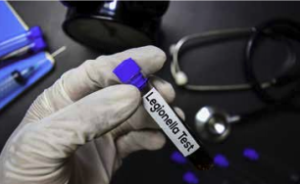Why are we still using 150-year-old technology to test…
 Between 2000 and 2019, the number of reported Legionnaires’ disease cases in the United States rose by 800%. This disease is caused by the Legionella bacteria and kills over 10% of people infected. Almost 10,000 cases of legionellosis (an umbrella term for two illnesses caused by Legionella bacteria) were reported in 2018 alone. This deadly waterborne disease is becoming more common, and building owners need to be aware of the danger. The median settlement for an individual Legionnaires’ lawsuit is around $2.7 million.
Between 2000 and 2019, the number of reported Legionnaires’ disease cases in the United States rose by 800%. This disease is caused by the Legionella bacteria and kills over 10% of people infected. Almost 10,000 cases of legionellosis (an umbrella term for two illnesses caused by Legionella bacteria) were reported in 2018 alone. This deadly waterborne disease is becoming more common, and building owners need to be aware of the danger. The median settlement for an individual Legionnaires’ lawsuit is around $2.7 million.
We covered the dangers of Legionella in our February edition and highlighted how the bacteria can occur anywhere that has a water system. Even the “Happiest Place on Earth” isn’t safe from Legionella. In 2017, an outbreak of Legionnaires’ disease in Anaheim, California, was traced back to cooling towers in Disneyland. The California Division of Occupational Safety and Health cited and fined Disneyland $33,000 for failing to properly clean the cooling equipment linked to the outbreak.
The best way to combat Legionnaires’ disease is to prevent Legionella from growing in your building’s water systems. Implement proper cleaning and maintenance of at-risk water systems, including hot water tanks, heaters, cooling towers, shower heads, sink faucets, hot tubs, and decorative fountains. In addition to proper cleaning, it’s crucial that building owners and property managers be proactive about monitoring and testing for Legionella bacteria. Unfortunately, the current method for detecting Legionella contamination is based on 150-year-old technology.
 It takes over a week to determine if a building is dealing with Legionella. A sample of the building’s water supply needs to be sent to a lab, where the sample is placed on a petri dish and left to sit for a week. At that time, lab technicians check the sample for Legionella. The drawbacks to this method are obvious. If it takes a week to get back test results, buildings that are facing Legionella growth could see more people get sick before they are able to act. To add insult to injury, the existing Legionella culture testing method is inaccurate and produced a false negative 62.5% of the time.
It takes over a week to determine if a building is dealing with Legionella. A sample of the building’s water supply needs to be sent to a lab, where the sample is placed on a petri dish and left to sit for a week. At that time, lab technicians check the sample for Legionella. The drawbacks to this method are obvious. If it takes a week to get back test results, buildings that are facing Legionella growth could see more people get sick before they are able to act. To add insult to injury, the existing Legionella culture testing method is inaccurate and produced a false negative 62.5% of the time.
This approach to Legionella analysis is outdated and dangerous. That’s why we recommend our clients look into the Spartan Legionella Detection System from Spartan Bioscience Inc. This is the first on-site Legionella DNA test, using medical-grade DNA testing. Designed with Nobel Prize-winning technology, the Spartan system detects all Legionella pneumophila serogroups in just 45 minutes. Not only is this method so much faster, but it’s also more accurate than the laboratory results.
The Spartan system is a big investment, costing over $8,000. Investing in this equipment isn’t something you should do on a whim. That said, if you are concerned about the risks and liability of an outbreak of Legionnaires’ disease coming from your building, then this equipment can go a long way to detect Legionella before it’s too late. Spartan Bioscience Inc.’s groundbreaking technology empowers building owners to be proactive about Legionella testing without the hassle that comes with outdated methods. Visit SpartanBio.com to learn more.
